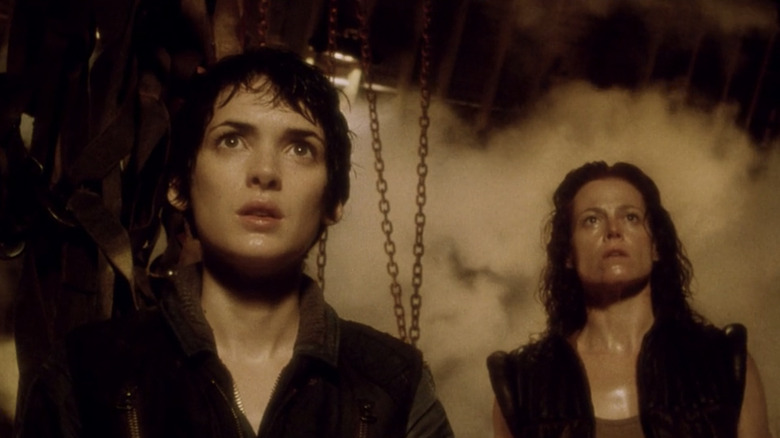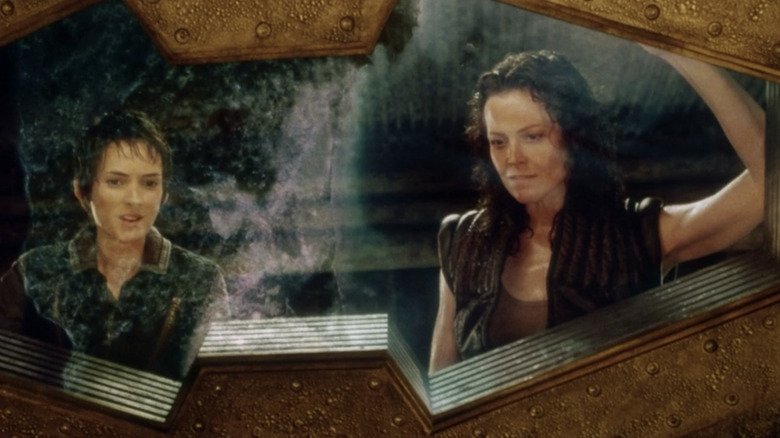Why Joss Whedon's Original Endings For Alien: Resurrection Never Made The Cut
The "Alien" movie series has staged its action on a number of different planets and spaceships, but by the time it reached its fourth installment, "Alien Resurrection," it had already long since teased the idea of bringing its acid-blooded Xenomorph to Earth. An early trailer for the troubled "Alien 3," released before the film's script and setting were even finalized, had promised, "In 1992, we will discover, on Earth, everyone can hear you scream."
In "Alien Resurrection," we do get a view of Earth at the end, as Ellen Ripley's clone (Sigourney Weaver), the synthetic being Call (Winona Ryder), and the other surviving crew members of the Betty ship enter the planet's atmosphere. The ship flies in over the clouds and Call asks Ripley, "What happens now?" To which Ripley replies, "I don't know, I'm a stranger here myself."
That's as close as she ever got to Earth. The series never really touched down there — unless you count the 2004 Antarctica-set crossover, "Aliens vs. Predator," which received rotten reviews and is perhaps best left forgotten. By that time, Weaver had moved on from the role of Ripley, and in the 2010s, when we finally started getting "Alien" films again with "Prometheus" and "Alien: Covenant," the franchise went back into outer space.
However, screenwriter Joss Whedon's original "Alien Resurrection" endings, guided by notes from 20th Century Fox and director Jean-Pierre Jeunet ("Amelie"), would indeed have taken Ripley to Earth back in 1997. The reason moviegoers never saw any of these endings all came down to money. "Alien Resurrection" was already a $70 million movie, and since the climax involves preventing the Xenomorphs from reaching Earth, it was easier to conclude it that way rather than finance another elaborate set piece on Earth.
A much different ending
According to Den of Geek, Whedon's first draft of "Alien Resurrection" has the Betty crash-landing in a forest, which becomes the setting for a fight between Ripley, Call, and the skull-faced human-Xenomorph hybrid, the Newborn. Ripley wields a grenade launcher and Call drives a flying harvester with threshing teeth. After that, Whedon rewrote the ending several times, with the final earthbound version shifting to a desert location. As he explained:
"The first [version] was in the forest with the flying threshing machine. The second one was in a futuristic junkyard. The third one was in a maternity ward. And the fourth one was in the desert. Now at this point this had become about money, and I said, 'You know, the desert looks like Mars. That's not Earth; that's not going to give people that juice.' But I still wrote them the best ending I could that took place in the desert."
Whedon was dead set on an Earth finale because he felt, "The reason people are here is we're going to do the thing we've never done; we're gonna go to Earth." However, the aforementioned budgetary concerns led to the abandonment of this and other ideas in the movie. What's left is a film that the screenwriter was unhappy with and that came in dead last in our ranking of the "Alien" movies.
In the intervening years since "Alien Resurrection," Whedon's career has itself crash-landed due to accusations of workplace harassment on the set of "Buffy the Vampire Slayer" and "Justice League." It's tough to say whether an earthbound ending for "Alien Resurrection" could have really redeemed the rest of the movie that came before it, but it would at least have given fans something they had never seen before.

